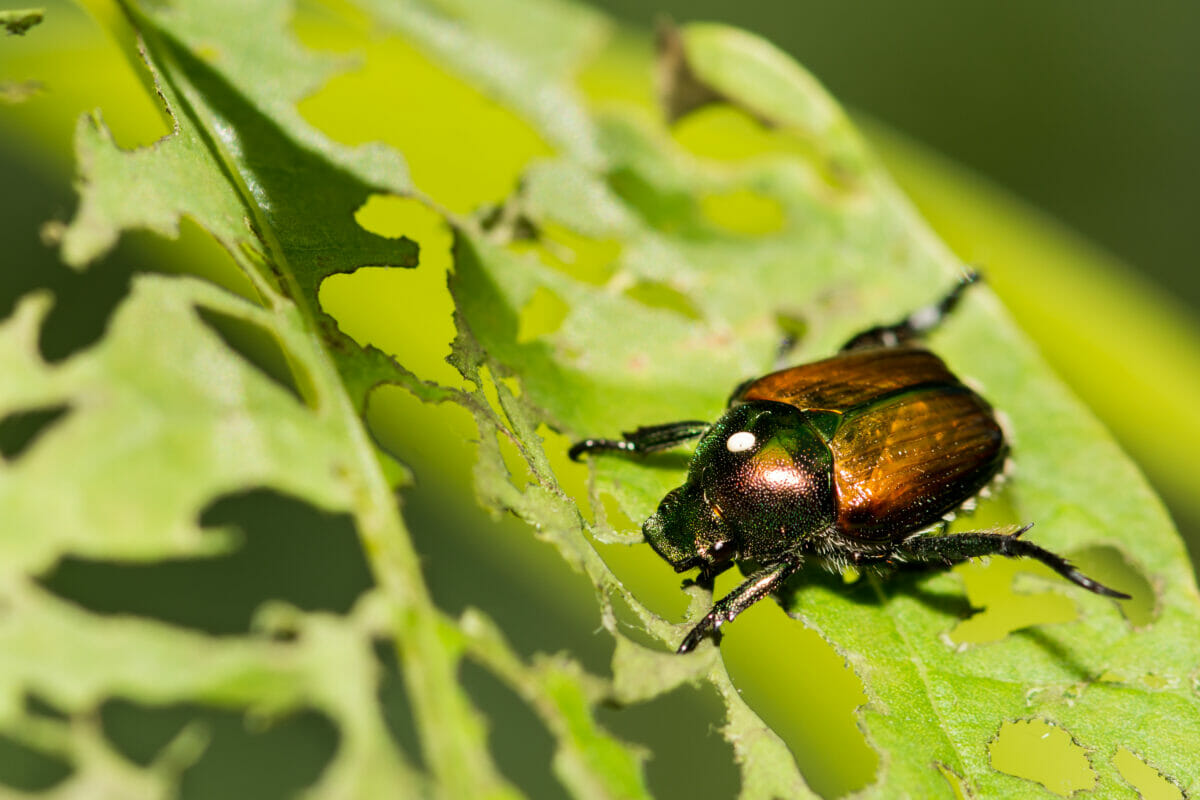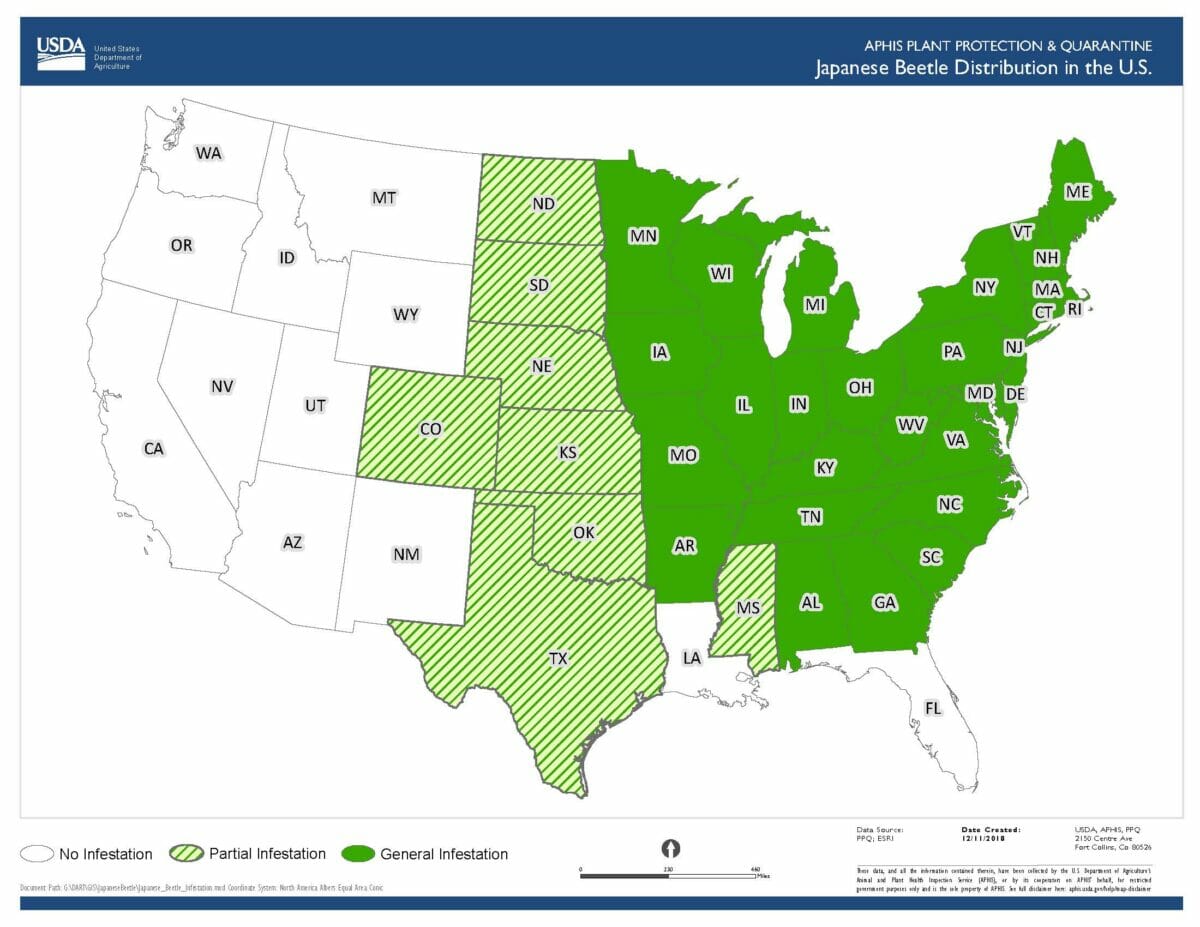Swift Intervention By Western States Is Keeping a Devastating Beetle at Bay
Scientists have modeled the projected spread of the Japanese beetle in Washington state, but they say management and public engagement can alter the outcome.
Swift Intervention By Western States Is Keeping a Devastating Beetle at Bay
Scientists have modeled the projected spread of the Japanese beetle in Washington state, but they say management and public engagement can alter the outcome.

A Japanese beetle eating a leaf.Jay Ondreicka, Shutterstock
With copper-colored wings and an emerald head, the Japanese beetle is pretty, but devastating.
Not native to the United States, the Japanese beetle was first detected on the East Coast in the early 1900s, and it began spreading across the country. The beetle has an appetite for more than 300 types of plants, including agricultural staples such as corn, hops, asparagus, cherries and more. The beetles eat plant leaves between the veins, leaving a cobweb-patterned mess behind. As of 2015, it was estimated that the US was spending more than $460 million annually to manage this pest.
Most states east of the Mississippi River have these beetles, and there have been infestations in some western states. A recent Washington State University study published in the Journal of Economic Entomology modeled the potential spread of the beetle across Washington state and found that, within two decades, if nothing is done to inhibit the beetle, it could be causing problems in all corners of Washington. The beetle’s first sighting in Washington was in the southern town of Sunnyside in 2020. Subsequently, the Washington State Department of Agriculture caught more than 20,000 beetles in the area.

Gengping Zhu, research assistant professor in the Department of Entomology at WSU and lead author of the study, says that this research can inform people about where they are likely to see the beetle, hopefully enabling interventions to take place.
Both official management plans and public engagement can help curtail the progress of the beetle. States such as Oregon and California have had repeated infestations, but they have effectively prevented full-on establishment through swift management action.
Interventions can include things such as localized quarantines—making sure yard waste and other soils don’t travel to outside areas. At the federal level, the USDA Animal and Plant Health Inspection Service utilizes a nationwide quarantine, specifically designed to prevent the spread of the beetle from eastern states to western states through air travel.
Many states have reporting forms online, where people can document sightings of the beetle. In parts of the country where the beetles are already pervasive, other innovative solutions are taking off, such as this 4-H project that turned into a beetle-busting business.
Stopping the spread of the beetle is preferable and more economically efficient than trying to address it after it has taken over, says Zhu. Adult beetles are easier to spot, but it’s even better to find them before the beetles can get to adulthood. “That’s the perfect window to control this beetle, but it’s harder to detect the eggs,” says Zhu.
The spread of the beetle is often attributable to human activity. Humans unknowingly transport beetles or their eggs/larvae through soil, potted plants, yard waste or other debris.
That’s why engaging and educating the public about the spread of non-native species can make a difference, no matter where you live. Zhu says public involvement has been hugely helpful thus far and will continue to be critical for the successful management of this species.
Follow us

This work is licensed under a Creative Commons Attribution-NoDerivatives 4.0 International License.
Want to republish a Modern Farmer story?
We are happy for Modern Farmer stories to be shared, and encourage you to republish our articles for your audience. When doing so, we ask that you follow these guidelines:
Please credit us and our writers
For the author byline, please use “Author Name, Modern Farmer.” At the top of our stories, if on the web, please include this text and link: “This story was originally published by Modern Farmer.”
Please make sure to include a link back to either our home page or the article URL.
At the bottom of the story, please include the following text:
“Modern Farmer is a nonprofit initiative dedicated to raising awareness and catalyzing action at the intersection of food, agriculture, and society. Read more at <link>Modern Farmer</link>.”
Use our widget
We’d like to be able to track our stories, so we ask that if you republish our content, you do so using our widget (located on the left hand side of the article). The HTML code has a built-in tracker that tells us the data and domain where the story was published, as well as view counts.
Check the image requirements
It’s your responsibility to confirm you're licensed to republish images in our articles. Some images, such as those from commercial providers, don't allow their images to be republished without permission or payment. Copyright terms are generally listed in the image caption and attribution. You are welcome to omit our images or substitute with your own. Charts and interactive graphics follow the same rules.
Don’t change too much. Or, ask us first.
Articles must be republished in their entirety. It’s okay to change references to time (“today” to “yesterday”) or location (“Iowa City, IA” to “here”). But please keep everything else the same.
If you feel strongly that a more material edit needs to be made, get in touch with us at [email protected]. We’re happy to discuss it with the original author, but we must have prior approval for changes before publication.
Special cases
Extracts. You may run the first few lines or paragraphs of the article and then say: “Read the full article at Modern Farmer” with a link back to the original article.
Quotes. You may quote authors provided you include a link back to the article URL.
Translations. These require writer approval. To inquire about translation of a Modern Farmer article, contact us at [email protected]
Signed consent / copyright release forms. These are not required, provided you are following these guidelines.
Print. Articles can be republished in print under these same rules, with the exception that you do not need to include the links.
Tag us
When sharing the story on social media, please tag us using the following: - Twitter (@ModFarm) - Facebook (@ModernFarmerMedia) - Instagram (@modfarm)
Use our content respectfully
Modern Farmer is a nonprofit and as such we share our content for free and in good faith in order to reach new audiences. Respectfully,
No selling ads against our stories. It’s okay to put our stories on pages with ads.
Don’t republish our material wholesale, or automatically; you need to select stories to be republished individually.
You have no rights to sell, license, syndicate, or otherwise represent yourself as the authorized owner of our material to any third parties. This means that you cannot actively publish or submit our work for syndication to third party platforms or apps like Apple News or Google News. We understand that publishers cannot fully control when certain third parties automatically summarize or crawl content from publishers’ own sites.
Keep in touch
We want to hear from you if you love Modern Farmer content, have a collaboration idea, or anything else to share. As a nonprofit outlet, we work in service of our community and are always open to comments, feedback, and ideas. Contact us at [email protected].by Lena Beck, Modern Farmer
August 10, 2023
Modern Farmer Weekly
Solutions Hub
Innovations, ideas and inspiration. Actionable solutions for a resilient food system.
ExploreExplore other topics
Share With Us
We want to hear from Modern Farmer readers who have thoughtful commentary, actionable solutions, or helpful ideas to share.
SubmitNecessary cookies are absolutely essential for the website to function properly. This category only includes cookies that ensures basic functionalities and security features of the website. These cookies do not store any personal information.
Any cookies that may not be particularly necessary for the website to function and are used specifically to collect user personal data via analytics, ads, other embedded contents are termed as non-necessary cookies.
Here in Minnesota, the University has had s verbal releases of the Winsome fly, which lays its eggs on the head of the Japanese beetle. The larvae burrow into and kill the adult JBs. They prefer females! This has already had a significant effect on JB populations in the target areas